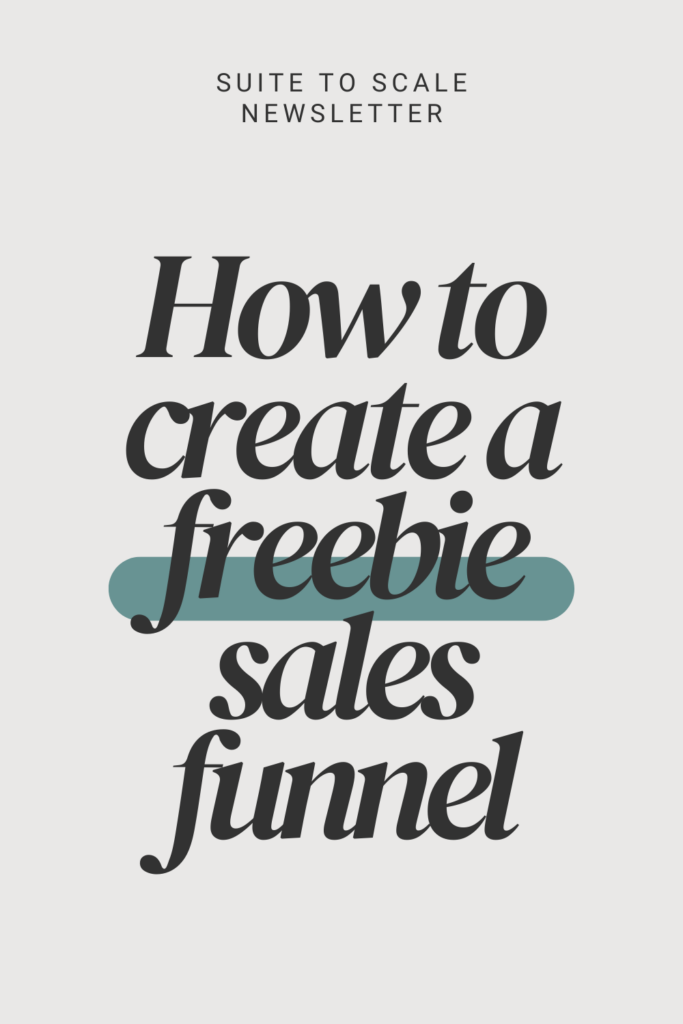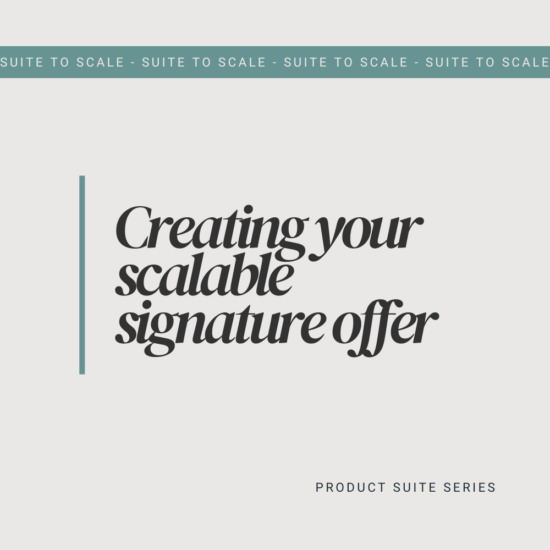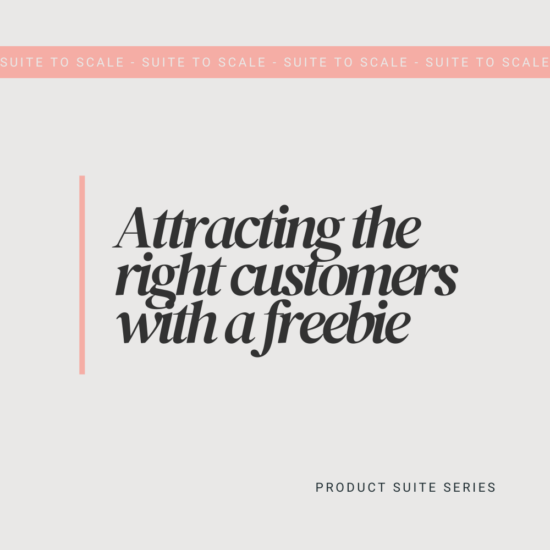Creating a freebie is a great start but it’s just the beginning.
If you stop at “download delivered,” you’re missing the entire purpose of the freebie: guiding people into your paid ecosystem.
That’s where a freebie funnel comes in.
A well-built freebie funnel doesn’t have to be complicated. But when it’s done right, it nurtures trust, qualifies your leads, and sells your product suite. All while running in the background.
In this post, you’ll learn how to build a simple, strategic funnel that turns your freebie into real revenue.
Quick Summary: This freebie funnel guide walks you through the step-by-step process of building a freebie funnel. It’s a strategic email and offer sequence that turns a new subscriber into a paying customer. You’ll learn what it is, what it needs, how to structure it, and how to make it work with your intro and signature offers.
What is a Freebie Funnel?
A freebie funnel is the journey that starts the moment someone downloads your lead magnet.
It’s the automated sequence (typically via email) that:
- Builds trust
- Delivers value
- Introduces a relevant paid offer
The goal isn’t to hard sell, it’s to show up as the guide, build connection, and make it easy for the right people to take the next step.
You don’t need a funnel that impresses marketers.
You need one that gets results.
What you need to build a Freebie Funnel
Here’s what you need to get started:
✅ A freebie that solves a real, immediate problem
✅ A thank-you page (bonus points if it includes an intro offer)
✅ A 3–5 email nurture sequence
✅ A low-friction paid offer (intro offer)
✅ An email tool that can segment and automate (*ConvertKit, *BeeHiiv)
You can build this funnel in a weekend and refine it over time, as long as you keep it simple.
The Funnel flow (step-by-step)
Let’s break down the freebie funnel structure into four parts:
Step 1: Freebie opt-in page
This is where your funnel journey begins. The goal is to get someone to say “yes” to your freebie with clarity and zero friction.
Key elements:
- Clear headline
Tell them exactly what they’re getting and why it matters.
Example: “Grab the Pinterest Audit Checklist to Quickly Spot Strategy Gaps”
- Benefit-driven subheading
Explain the quick win or transformation they’ll walk away with.
Example: “In just 10 minutes, identify what’s working (and what’s not) on your client’s Pinterest profile.”
- CTA button
A clear, action-focused button.
Example: “Send Me the Checklist”
- Segmentation question (optional)
A simple multiple-choice or dropdown that helps you identify what stage they’re in.
Example: “Are you a Pinterest Manager or a DIY Business Owner?”
This helps you tailor future emails and offers based on who they are.
💡 Keep the form simple. Ask only for what you need.
Step 2: Thank-you page
This page does two jobs:
- Confirms the freebie is on its way
- Offers an optional next step
This is a prime spot to present your intro offer. Think of it like a “Would you like fries with that?” moment.
- Example: “Want to turn your Pinterest audit into a full strategy? Grab the Pinterest Playbook for just $27.”
💡 Tip: Use a countdown timer if you have a limited time discount on the page. Alternatively use a “limited-time” bonus to increase conversions. The bonus could be a template or training that they get if they buy within the timeframe. Remember to give them enough time to consider the purchase and read your sales copy.
Step 3: Email nurture sequence
Here’s a high-converting 5-email structure:
- Email 1: The welcome email. Deliver the freebie + set expectations
(“Here’s your checklist. Over the next few days, I’ll help you turn it into action.”) - Email 2: Build connection with a personal story or client win
(“When I first started managing Pinterest, I made this one mistake…”)
Mention your paid offer lightly. - Email 3: Educate + give a quick win
Solve a related micro-problem. This builds trust. - Email 4: Present the paid offer clearly
Focus on outcomes, not features.
Use a CTA like: “If you’re ready to build your strategy, here’s how I can help.” - Email 5: Objections, FAQ, or reminder email
Share testimonials, address hesitation, or include a soft deadline.
💡 You can shorten this to 3 emails or expand to 7 based on your offer type and audience.
Step 4: Paid offer landing page
This is where your subscriber makes their first buying decision.
Your paid offer should be your intro offer: a small, value-packed, low-friction product (typically $7–$49) that directly builds on the freebie they just downloaded.
What to include on this page:
- Restate the transformation
Reconnect with the challenge your freebie solved and show how this offer takes it further.
Example: “If the checklist helped you audit Pinterest… this playbook helps you build the full strategy.” - Testimonials or quick wins
Social proof builds trust, especially for low-ticket offers. Pull in 3-5 testimonials or show what others have achieved using the offer. - A clear breakdown of what’s included
Use bullet points or visuals to keep it scannable. Include bonuses if you want to increase perceived value. - Friendly, low-pressure CTA (call-to-action)
Think: “Ready to take the next step?” or “Upgrade your checklist into a full strategy with the Playbook.”
💡 Tip: This page can live right on the thank-you page, or it can be linked from emails in your nurture sequence.
Suite to Scale Newsletter:
Get expert tips every Wednesday on product suite creation, sales funnels, and impactful program design—all tailored for service business owners like you.
Freebie Funnel guide examples
Let’s look at how this structure works in different businesses.
💡 Note: This is just the beginning of the sales funnel.
The funnel can expand to include your other future offers including: upsells, add-ons, ongoing offers, and signature offers. We’re just going to focus on freebie sales funnel examples that lead into one intro paid offer.
Example: Service provider (Pinterest manager)
- Freebie:
Pinterest Audit Checklist (PDF with step-by-step client audit instructions) - Thank-you page:
“Your checklist is on the way! Want to turn it into a full strategy?”
→ Offers the Pinterest Strategy Playbook for $27
→ Includes a bonus template if purchased within 15 minutes - Email sequence:
- Email 1: Checklist delivery + what to do next
- Email 2: “How I used this checklist to build Pinterest strategies for 1:1 clients” + soft intro to the Playbook
- Email 3: Common Pinterest strategy mistakes
- Email 4: Direct offer email with CTA for the Playbook
- Email 5: “Still wondering if the Playbook is for you?” (FAQ + testimonial)
- Email 6: Bonus sneak peek or “behind the product”
- Email 7: Final reminder or deadline-driven CTA
- Email 1: Checklist delivery + what to do next
- Intro offer landing page:
- What’s inside the Playbook
- How it builds off the checklist
- Testimonials from Pinterest managers
- Clear CTA: “Get the Playbook + Bonus Strategy Template for $27”
- What’s inside the Playbook
Example: Coach
- Freebie:
Goal-Setting Journal Template (fillable PDF) - Thank-you page:
“Want to turn this into a complete 90-day action plan?”
→ Offers the Breakthrough Planning Workbook for $19
→ Includes bonus affirmations pack if purchased now - Email sequence:
- Email 1: Delivery + how to use the journal
- Email 2: Coach’s story of burnout → planning breakthrough
- Email 3: “What’s keeping you stuck” insight
- Email 4: Offer-focused email with a walkthrough of the workbook
- Email 5: Reminder + testimonial from a past buyer
- Email 1: Delivery + how to use the journal
- Intro offer landing page:
- Workbook preview images
- Transformation promise: “Plan with clarity and calm”
- Bonus breakdown
- CTA: “Get your workbook now for just $19”
- Workbook preview images
Example: Digital creator (template shop owner)
- Freebie:
Notion Weekly Planning Dashboard - Thank-you page:
“Upgrade to the full Business Toolkit — includes 10+ Notion templates”
→ Offers the Digital Business Toolkit for $37
→ Upsell option to grab the monthly template vault - Email sequence:
- Email 1: Delivery + demo of the free template
- Email 2: “How I run my biz using just Notion” (screenshots + tips)
- Email 3: Offer email → toolkit overview + CTA
- Email 4: “How I designed the toolkit” behind-the-scenes story
- Email 5: “What’s possible when you systemize your week” + final offer push
- Email 1: Delivery + demo of the free template
- Intro offer landing page:
- Template highlights
- Before/after scenarios
- Bonus: Social media content planner
- CTA: “Buy the toolkit + get 2 months of updates free”
- Template highlights
Mistakes to avoid (and what to do instead)
❌ Only sending one email after the freebie
→ Instead: Create a short nurture sequence to build connection and trust.
Sometimes only having one email works (I have one funnel like this), but in general when you create a freebie funnel you want to include a few emails to guide your subscriber toward the right solution.
❌ Offering something unrelated or too expensive
→ Instead: Your intro offer should feel like the obvious next step.
❌ Jumping straight to a $997 signature offer
→ Instead: Start small with a low-ticket, low-risk paid offer.
❌ Treating it like a sales funnel only
→ Instead: Treat it like a relationship funnel and prioritize service.
✨ Real-life example: A simple funnel that grew an email list + signature sales
Here’s how I built a high-converting freebie funnel using a simple system:
- Freebie: Pinterest Manager Checklist
- Thank you page: Confirmed delivery + presented the Pinterest Strategy Playbook intro offer at a discounted rate.
- Email sequence: A 7-part welcome sequence that included the Playbook as a soft CTA in most emails, with two emails focused entirely on selling the offer.
- List strategy:
After the funnel, subscribers entered my main email list. I regularly:- Included the Playbook in general newsletters
- Launched new offers to this list
- Built connection through story-driven and educational content
- Eventually sold my signature course to subscribers who started with the freebie
- Included the Playbook in general newsletters
This funnel created a journey that nurtured cold leads into loyal customers, and helped me scale my offers over time.
My thoughts:
Your funnel isn’t there to pressure people, it’s there to guide them.
A good freebie funnel feels like a helpful concierge, not a pushy salesperson.
It’s about showing up for your ideal client and making their next best step obvious.
Your next step: Build your funnel, your way
This doesn’t need to be perfect to start working.
Start with:
- A clear freebie
- A short email sequence
- A $19–$49 intro offer that aligns with what they downloaded
👉 Need help creating a freebie that works? [Read the lead magnet blog post]
👉 Need help crafting the perfect intro offer? [Read the intro offer blog post]
*Affiliate Links: I may receive a commission if you purchase using one of my links (at no cost to you).
- ConvertKit: Get a 14-day free trial.
- Beehiiv: Get a 30-day free trial + 20% OFF for 3 months.







